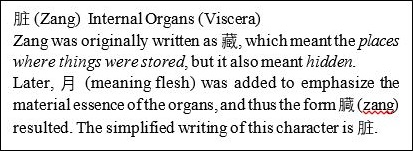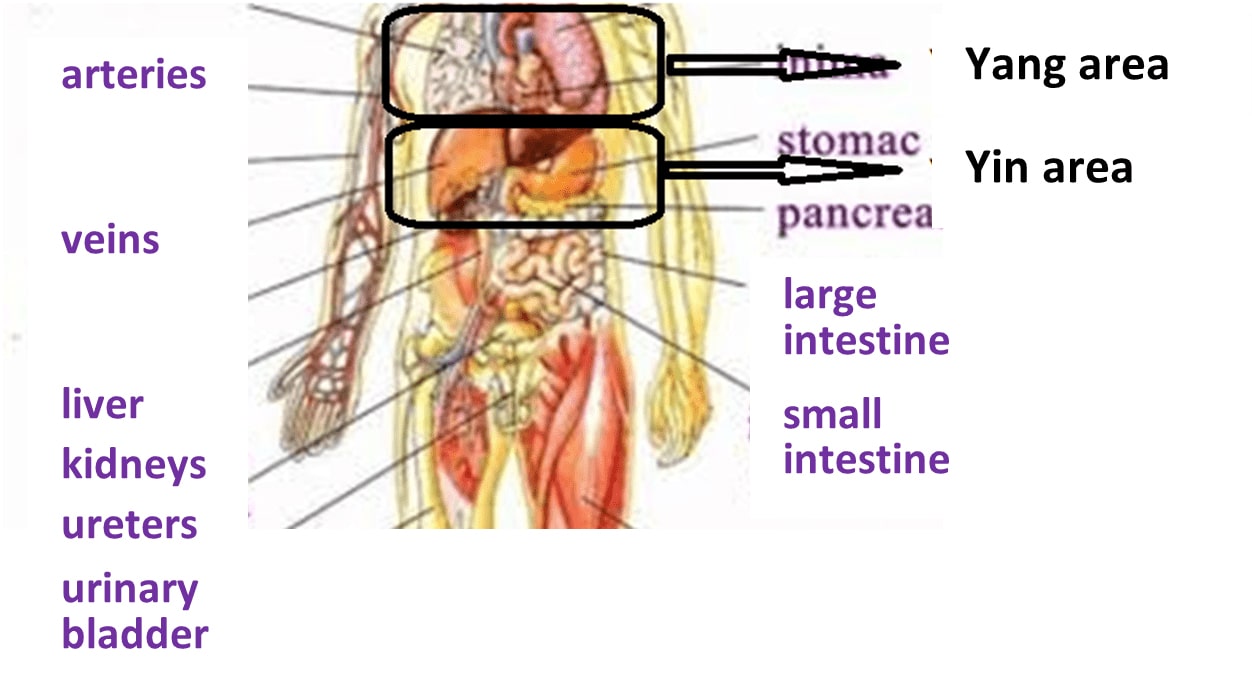I. In Traditional Chinese Medicine, internal organs are classified into: 五脏 (wuzang) and 六腑 (liufu)
Wuzang (5 viscera) include:
– Heart (心 xin)
– Lungs (肥 fei)
– Liver (肝 gan)
– Kidneys (肾 shen)
– Spleen (脾 pi)
Liufu (6 bowels) include:
– Stomach (胃 vei)
– Gallbladder (胆 dan)
– Large intestine (大肠dachang)
– Small intestine (小肠 xiaochang)
– Urinary bladder (膀胱 pangguang)
– Triple burner (三焦sanjiao)



II. Classification of the Zang-Fu organs according to Yin and Yang
1. According to the function of the organs (the inward-oriented functions are Yin and the outward-oriented ones are Yang):
– the 5 zang organs are Yin (for they collect the jing-qi and store it) -> 藏而不泻
– the 6 fu organs are Yang (for they transform matter and do not store it, but discharge it) -> 泻而不藏
2. According to the location of the organs (those in the upper area are Yang, and those in the lower area are Yin)
– the group of organs above the diaphragm – heart, lungs – is Yang
– the group of organs below the diaphragm – liver, spleen, kidneys – is Yin
3. According to hollowness and solidity (hollowness is Yang, solidity is Yin)
– the 5 zang organs are solid; however, since essence and qi flow through them, they are solid, but not full(满而不实)
– the 6 fu organs are hollow; however, since they transform water and food, and when the stomach is full, the bowels are empty or when the bowels are empty, the stomach is full, the 6 fu organs are full, but not solid(实而不满)
Note: 实 (shi), translated above as full, is the antonym of emptiness (虚 xu)
III. Viewed individually, the organs have the following Yin-Yang features:
The heart is the yang within yang(阳中之阳)
The lungs are the yin within yang(阳中之阴)
The liver is the yang within yin(阴中之阳)
The kidneys are the yin within yin(阴中之阴)
The spleen is the extreme yin(至阴)

The relationships above are established as follows:
Odd numbers are yang; even numbers are yin.
The heart and the liver are made up of a single unit, therefore they stand for an odd number -> yang
The lungs and the kidneys are made up of two units, hence they stand for an even number -> yin
E.g.: the kidneys are yin and, since they are located in the lower area (which is yin), they are called the yin within yin
E.g.: the lungs are yin and, since they are located in the upper area (which is yang), they are called the yin within yang
IV. Presentation of the 5 organs in The Inner Canon of the Yellow Emperor(黄帝内经)
素问·六节脏象论篇第九
帝曰:脏象何如?
岐伯曰:心者,生之本,神之变也;其华在面,其充在血脉,为阳中之太阳,通于夏气。
肺者,气之本,魄之处也;其华在毛,其充在皮,为阳中之太阴,通于秋气。
肾者,主蛰,封藏之本,精之处也;其华在发,其充在骨,为阴中之少阴,通于冬气。
肝者,罢极之本,魂之居也;其华在爪,其充在筋,以生血气,其味酸,其色苍,此为阳中之少阳,通于春气。
脾、胃、大肠、小肠、三焦、膀胱者,仓廪之本,营之居也,名曰器,能化糟粕,转味而入出者也,其华在唇四白,其充在肌,其味甘,其色黄,此至阴之类,通于土气。
凡十一脏,取决于胆也。
The Emperor asked: What is the manifestation of the hidden [organs]?
Qi Bo replied: The Heart [is] the root of life, it [is] the divine transformation; it blooms in the face [and] fills up the blood vessels; it is the supreme Yang within Yang [and] transmits the summer qi.
The Lungs [are] the roots of qi, they [are] the place where spirit resides; they bloom in the [body] hair [and] fill up the skin; they are the supreme Yin within Yang [and] transmit the autumn qi.
The Kidneys [are] the origin of hibernation, they [are] the roots of hiding and sealing, the residence of the essence; they bloom in the hair [on the head] [and] fill up the bones; they are the little Yin within Yin [and] transmit the winter qi.
The Liver [is] the place of exhaustion and supreme rest, it [is] the residence of the soul; it blooms in the nails [and] fills up the muscles; it generates the qi of blood; its flavor is [sour], [and] its color [is] greenish; it is the little Yang within Yang [and] transmits the spring qi.
The Spleen, the stomach, the large intestine, the small intestine, the triple burner [and] the urinary bladder [are] the basis of grain storage, they [are] the camp1, [and] their name is 器 (qi); that can transform waste2, they [can] turn (alternate) flavors so they can enter and leave these organs; [these organs] bloom in the lips and the white flesh surrounding the lips; they fill up the flesh and tendons; their flavor is sweet, their color is yellow; they are a sort of zhiyin3 [and] transmit the earth qi. [The actions of] all 11 organs are decided by the gallbladder.
1camp – the 营 (ying) character used to indicate labor or military camps, i.e. the place where large actions involving a high number of resources took place.
2waste – 糟 粕(zaopo) is the pomace or marc that remains after making alcohol; in a broad sense, it means waste.
3zhiyin(至阴)- is the Yin that reached an extreme point.
Note: “To bloom” means to open up; it is the image of the flower that opens and closes cyclically (to day-night rhythms). For example, in the case of the lungs, the pores of the skin open and close.
V. Culture and Medicine
The following expressions can be found in common Chinese:
– The heart is called 君主之官 (the Sovereign’s chancellery) or 生之本 (the root of life)
– The lungs are called 相府之官 (the rulers’ office) or气之本 (the root of qi)
– The spleen is called 仓廪之官 (the place of the quartermaster) or仓廪之本 (the basis of grain storage)
– The liver is called 将军之官 (the general’s headquarters) or罢极之本 (the root of exhaustion to the utmost1)
– The kidneys are called 作强之官 (the place where the power is established) or 封藏之本 (the basis of sealed storage)
1 Note: 罢 (ba) has two meanings: exhaustion and stopping. Although most interpretations refer only to exhaustion, there are other opinions saying that both meanings refer to the liver: the general is the one who exhausts people through military actions, but also the one who brings rest by establishing peace.


